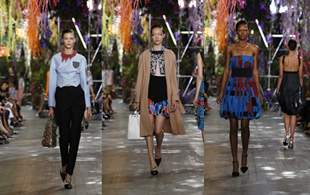FW
Swiss textiele machinery maker Rieter expects financial year 2013 to give better results with its spun yarn systems and premium textile components. The company is expecting a net profit of around 3.5 per cent of sales. Rieter is a leading world supplier of textile machinery and components used in short staple fiber spinning. Based in Switzerland, the company develops and manufactures systems, machinery and technology components used to convert natural and manmade fibers and their blends into yarns. It is the only supplier worldwide to cover spinning preparation processes as well as all four final spinning processes currently established in the market.
Rieter received 50 per cent improvement in orders for its spun yarn systems and a 21 per cent improvement in orders for premium textile components. Short staple fiber machinery and components gained momentum during 2013. There was notable growth in Rieter’s business in the second semester, especially for rotor spinning machines. The first half year showed strong demand in China and because of Rieter’s local presence in the market. There was healthy demand from Pakistan, Uzbekistan, South Korea, Bangladesh, Indonesia and Vietnam. Order level from India rose in the second half of the year at a modest level.
www.rieter.com/
Cases have been filed against 1,683 factories and establishments in Bangladesh, including 392 garment units, for doing business without valid approval and adequate safety measures. Inspectors are focusing mainly on fire safety standards, including fire prevention measures, electrical safety, number of staircases, provision of 25 per cent open rooftop and a valid license. They found workers were not registered, no appointment letters and identification cards with no photos, no regular fire drills, obstacles in passages and absence of benefits like maternity leave. Besides, a large number of factories were not fully compliant with fire safety standards.
However, it’s doubtful if such a step will yield positive results. For one, fines are too low to deter offenders. Many a time, owners pay the penalty and carry on as usual. The inspection teams themselves are facing a shortage of manpower. The ministry has made a move to appoint additional 200 inspectors by March next.
The government is focusing on garment factories due to frequent accidents, pressure from the buyers, and the image crisis the sector is now facing. The country’s garment industry has in recent times been hit by a series of devastating fires and building collapses leading to loss of lives and damage to property.
 REPORT_ Under Armour has announced its financial results for the fourth quarter ended December 31, 2013 with net revenue increase of 35 percent to 683 million dollars compared with net revenues of 506 million dollars in the prior year's period. For the full year 2013, net revenues increased 27 percent to 2.33 billion dollars compared with 1.83 billion dollars in the prior year and compared with the company's prior outlook of 2.26 billion dollars.
REPORT_ Under Armour has announced its financial results for the fourth quarter ended December 31, 2013 with net revenue increase of 35 percent to 683 million dollars compared with net revenues of 506 million dollars in the prior year's period. For the full year 2013, net revenues increased 27 percent to 2.33 billion dollars compared with 1.83 billion dollars in the prior year and compared with the company's prior outlook of 2.26 billion dollars.
Diluted earnings per share for 2013 increased 24 percent to 1.50 dollars compared with 1.21 dollars per share in the prior year. Diluted earnings per share for the fourth quarter of 2013 increased 27 percent to 0.59 dollars compared with 0.47 dollars in the prior year’s period.
with 1.21 dollars per share in the prior year. Diluted earnings per share for the fourth quarter of 2013 increased 27 percent to 0.59 dollars compared with 0.47 dollars in the prior year’s period.
Fourth quarter apparel net revenues increased 35 percent to 546 million dollars compared with 405 million dollars in the same period of the prior year, primarily driven by expanded Fleece offerings and new ColdGear Infrared products. Fourth quarter footwear net revenues increased 24 percent to 55 million dollars from 45 million dollars in the prior year's period. Fourth quarter accessories net revenues increased 52 percent to 65 million dollars from 43 million dollars in the prior year's period, primarily driven by headwear and gloves.
Commenting on the results, Kevin Plank, Chairman and CEO of Baltimore-based Under Armour stated, “By any measure, 2013 was a banner year for the UA Brand. We surpassed 2 billion dollars in net revenues for the year, which culminated with our 15th straight quarter of at least 20 percent total growth. In addition, we completed our first acquisition, MapMyFitness, opened our first two UA Brand House retail stores, and continued to make key investments in our Women's, Footwear and International businesses to drive long-term global growth. While we are proud of what we have accomplished to date, we firmly believe we are just getting started and that our performance in 2013 is indicative of the opportunity that lies ahead for Under Armour.”
Apparel net revenues for the year 2013 increased 27 percent to 1.76 billion dollars compared with 1.39 billion dollars in the prior year, led by elevated newness across product categories like HeatGear and Fleece as well as innovation platforms including Storm, ColdGear Infrared and Charged Cotton. Footwear net revenues increased 25 percent and accessories net revenues increased 30 percent, primarily driven by headwear and gloves.
Based on current visibility, the company expects 2014 net revenues in the range of 2.84 billion dollars to 2.87 billion dollars, representing growth of 22 percent to 23 percent over 2013, and 2014 operating income in the range of 326 million dollars to 329 million dollars, representing growth of 23 percent to 24 percent over 2013.
Added Plank saying, “We have tremendous momentum across our business and we will leverage this strength to fuel our global growth ambitions in 2014. To start, we have recently formed partnerships with three sports programs with deep, proud heritages: the University of Notre Dame, the U.S. Naval Academy, and the Colo Colo fútbol team in Chile.”
NALYSIS_ In an unexpected movement, Men's Wearhouse Inc (MW.N) has just said it is open to sweetening its buyout offer for Jos. A. Bank Clothiers Inc (JOSB.O). The now suitor has outlined new conditions to appeal to its rival management and called on independent directors of Jos. A. Bank Clothiers Inc to reconsider its bid.
"We are writing to you, the independent directors of Jos. A. Bank Clothiers, Inc. ("JOSB"
 or the "Company"), regarding our all-cash 57.50 dollars per share offer to acquire the Company. As we have made clear, our strong preference is to work collaboratively with the JOSB Board and management to realise the benefits of this combination. Our offer would provide your shareholders with a substantial premium and immediate and certain value," reads the letter, dated on January, 30. the wake of the news, Jos. A. Bank shares were up marginally in early tradingThursday after rising as much as 3 percent before the bell.
or the "Company"), regarding our all-cash 57.50 dollars per share offer to acquire the Company. As we have made clear, our strong preference is to work collaboratively with the JOSB Board and management to realise the benefits of this combination. Our offer would provide your shareholders with a substantial premium and immediate and certain value," reads the letter, dated on January, 30. the wake of the news, Jos. A. Bank shares were up marginally in early tradingThursday after rising as much as 3 percent before the bell.
Barely days before the new turn for the complex hate-love relationship between the two US-based menswear giants, had Men's Wearhouse declared a quarterly dividend for investors of record on Tuesday, March 18th, who will be given a dividend of 0.18 dollars per share on Friday, March 28th. This represents a 0.72 dollars dividend on an annualised basis and a yield of 1.52 percent.
Men´s Wearhouse to lure independent directors at Jos A. Bank
"Our offer represents a 52 percent premium over JOSB's unaffected enterprise value and a 38 percent premium over the closing share price on October 8, 2013, the day prior to the Company's public announcement of its proposal to acquire Men's Wearhouse."
"Further, the transaction represents a 9.4x enterprise value to last twelve months ("LTM") Adjusted EBITDA multiple (assuming 135 million dollars of LTM Adjusted EBITDA as of November 2, 2013), which is a significant premium to Jos. A. Bank's proposal to acquire Men's Wearhouse, in excess of Jos. A. Bank's historical average trading multiple and near the upper end of recent precedent apparel retail transactions. Moreover, we are prepared to increase our offer price if you can demonstrate or we can discover additional value through discussions or limited due diligence."
Jos. A. Bank Clothiers Inc. (JOSB), which is resisting a takeover by Men's Wearhouse Inc., would have allegedly told by five of its largest shareholders to start talking to its rival about a sale, as per sources quoted by Bloomberg.
Firms including P. Schoenfeld Asset Management LP and Beacon Light Capital LLC would have urged Jos. A. Bank to engage Men's Wearhouse and discuss its 1.61 billion dollars hostile bid anonymous sources close to the matter have pointed out. The five investors own about 17 percent of Jos. A. Bank, according to the people and data compiled by Bloomberg.
 REPORT_ Salvatore Ferragamo consolidated revenues for the fiscal year 2013 were up by 9 percent at current exchange rates and by 11 percent at constant exchange rates versus financial year 2012. All geographical areas, with the sole exception of Japan, registered in financial year 2013 a double-digit growth in turnover. The Asia Pacific area is confirmed as the group’s top market in terms of revenues, representing about 37 percent of the total in financial year 2013. A major contribution was given by the retail channel in China, which recorded a 20 percent growth compared to the same period in 2012.
REPORT_ Salvatore Ferragamo consolidated revenues for the fiscal year 2013 were up by 9 percent at current exchange rates and by 11 percent at constant exchange rates versus financial year 2012. All geographical areas, with the sole exception of Japan, registered in financial year 2013 a double-digit growth in turnover. The Asia Pacific area is confirmed as the group’s top market in terms of revenues, representing about 37 percent of the total in financial year 2013. A major contribution was given by the retail channel in China, which recorded a 20 percent growth compared to the same period in 2012.
Europe posted an increase in revenues of 13 percent, compared to the same period in  2012. Double-digit revenue growth was recorded also in North America, with an increase of over 12 percent in financial year 2013. The Japanese market showed an increase in revenues of one percent in financial year 2013. Revenues in Central and South America showed an increase of 15 percent. Salvatore Ferragamo is based in Italy. The group is active in the creation, production and sale of shoes, leather goods, clothing, silk products and other accessories, as well as women’s and men’s perfumes. The group’s product range also includes eyewear and watches, manufactured by licensees.
2012. Double-digit revenue growth was recorded also in North America, with an increase of over 12 percent in financial year 2013. The Japanese market showed an increase in revenues of one percent in financial year 2013. Revenues in Central and South America showed an increase of 15 percent. Salvatore Ferragamo is based in Italy. The group is active in the creation, production and sale of shoes, leather goods, clothing, silk products and other accessories, as well as women’s and men’s perfumes. The group’s product range also includes eyewear and watches, manufactured by licensees.
As of December 31, 2013, the Salvatore Ferragamo group’s retail network consisted of 360 Directly Operated Stores while the wholesale and travel retail channel included 264 Third Party Operated Stores as well as a presence in major department stores and high-end multi-brand specialty stores. In financial year 2013 the retail distribution channel posted consolidated revenues up by 9 percent compared to the same period in 2012. The wholesale and travel retail channel delivered an excellent performance in financial year 2013 growing 14 percent.
 ANALYSIS_LVMH took Paris bourse by storm Friday after the world largest luxury goods group hit the 6 billion euros annual profit landmark for the first time. The 2 percent rise in profit for the full year boosted the stock by nearly 7 percent to 131 euros. LVMH was a winnerFriday, not only in terms of full-year profit, but also on the trading floor. The shares advanced as much as 6.9 percent, the sharpest intra-day gain since May 10, 2010.
ANALYSIS_LVMH took Paris bourse by storm Friday after the world largest luxury goods group hit the 6 billion euros annual profit landmark for the first time. The 2 percent rise in profit for the full year boosted the stock by nearly 7 percent to 131 euros. LVMH was a winnerFriday, not only in terms of full-year profit, but also on the trading floor. The shares advanced as much as 6.9 percent, the sharpest intra-day gain since May 10, 2010.
The French luxury giant got an important push from its fashion and leather-goods  divisions, which sales rose 7 percent on an organic basis in the final three months of the year. Growth accelerated from 4 percent in the first nine months of 2013, after a weaker third quarter. Sales for the year came in at 29.1 billion euros, that is it a 4 percent on the previous year. Profit reached 6.021 billion pounds, a record amount that came in 2 percent up year-on-year.
divisions, which sales rose 7 percent on an organic basis in the final three months of the year. Growth accelerated from 4 percent in the first nine months of 2013, after a weaker third quarter. Sales for the year came in at 29.1 billion euros, that is it a 4 percent on the previous year. Profit reached 6.021 billion pounds, a record amount that came in 2 percent up year-on-year.
Despite the green sprouts, market remains cautious, as although the results showed improvement in the fourth quarter of 2013, the annual sales growth remained below the previous year´s.
Commenting the results, the group reminded that, in order to improve performance and turnover, LVMH has launched a more expensive range of "very high quality leather products" where it today said "profitability remains at an exceptional level."
LVMH shares hit 3-year record high in Paris
The improved performance of the unit was the "main positive" in yesterday's full-year results, Rogerio Fujimori, an analyst at Credit Suisse, said in a note.
LVMH shares gained nearly 7 percent on the positive outlook and reverted thus the last twelve months´ 7.6 percent fall due to slowing luxury-goods sales in Asia.
Profit from recurring operations climbed 2 percent to 6.02 billion euros, in line with the median of 19 analysts' estimates compiled by Bloomberg. Similarly, total 2013 revenue advanced to 29.15 billion euros. Analysts predicted 29.4 billion euros. Sales rose 8 percent on an organic basis, matching estimates.
"Despite an uncertain economic environment in Europe, LVMH is well-equipped to continue its growth momentum across all business groups in 2014," the company said.
Kingpins will be organizing its maiden denim trade show at Amsterdam on May 7, 2014. This is its first show at this venue. So far there have been editions at places like New York, Bangalore, Los Angeles and Hong Kong, New Delhi, Hong Kong. It may be known that the Netherlands has the biggest density of denim brands in the world.
The first two days will focus on the business-to-business side of denim. The following two days will include consumers with pop-up shops, laser-finishing workshops, a vintage market, and parties and events for denim lovers and addicts.
The invite only Kingpins Show started in 2004 for the denim supply chain and facilitates networking and relationship-building. The exhibitors list include chemical companies and fiber companies who have new, innovative products, denim and sportswear fabric mills from the US, Japan, China, India, Morocco, Mexico and Europe, wash houses, full package manufacturers, trim providers and business solutions.
Kingpins is about casual wear: jeans, denim, garment dyeing, cotton and fibers. The show attracts global leaders like the best global fiber producers, denim mills, the best piece dyed producers, the chemical companies, industrial laundries, sewing factories, hardware companies and label manufacturers. <br/>
www.kingpinsshow.com/
Sri Lanka’s apparel exports in 2013 reached an all-time record of $4.3 billion compared to $3.8 billion dollars in 2012. The country expects to be among the top 10 apparel exporters of the world by 2020. The Sri Lankan government is offering various incentives where by Sri Lankan entities can now place orders in other low cost bases in the region, bring back to Sri Lanka, add value and export. Multi country consolidation which is offering enormous opportunities is also now possible. A free trade agreement has been proposed with China.
Sri Lanka’s apparel export industry is the country’s primary forex earner accounting for 40 per cent of total exports. There are around 350 garment factories and around 16 textile and fabric manufacturing units. Apparel categories include: sportswear, lingerie, lounge wear, bridal wear, work wear, swim wear, children’s wear. The US and the United Kingdom have historically been the largest buyers of Sri Lankan apparel throughout the decades.
The apparel industry prides itself on the fact that it doesn’t employ children. It has implemented ethical sourcing and sustainable eco-friendly development practices. It aims to empower women and support their communities through poverty alleviation and offering opportunities for education and personal growth. The endeavor is to make the ‘Made in Sri Lanka’ label synonymous with quality, reliability and social and environmental accountability.
EDANA and INDA, the leading international trade associations for the nonwovens and engineered fabrics industries based in Europe and North America, have announced they will harmonize their mission and vision to advance the success of their member companies. A statement from INDA said, “Responding to the needs of each association’s member companies, including those companies that belong to both organizations, this new initiative was drawn from the values and missions pursued by both associations over their more than 40 years of operation.”
“INDA and EDANA have kept parts of each association’s individual positions that are essential to their own nature and character, and have formed a mutual position that not only strengthens the relationship between the two associations, but seeks to provide cohesion and consistency on a global basis. Each organization will continue to operate independently.”
Members of both global organizations are involved in the complete nonwovens supply chain from raw materials, machinery and equipment to roll goods, converters and end products. The services provided by each association are similar in nature, but are said to be unique in delivery and influence. Both associations provide services in product stewardship (safety standards, test methods and sustainability); government and regulatory affairs; commerce and innovative industry events; industry awareness and trust; and training, education and market research.
EDANA serves more than 240 companies across 36 countries in the nonwovens and related industries, helping its members to design their future. Whereas, INDA, the Association of the Nonwoven Fabrics Industry, serves hundreds of member companies in the nonwovens and engineered fabrics industry doing business globally. Since 1968, INDA events have helped members connect, learn, innovate and develop their businesses.
www.inda.org
In his address at the annual meeting of the International Foundation of Fashion Technologies Institutes (IFFTI) in Tokyo, IAF Secretary General Han Bekke urged the fashion industry to rethink its business model. The apparel industry worldwide is still focused on price, which in some cases leads to dramatic situations like last year in Bangladesh.
“The economic situation in important markets for apparel has a negative impact on consumer spending on clothing”, Bekke said, adding, “feeling also the intense competition from fast fashion models, fashion retailers often react with mark downs with heavy pressure on margins as a result. The question where can I produce the cheapest is then asked more often than how can I serve the consumer best. This is no longer sustainable and kills creativity and innovation.”
In Bekke’s view more cooperation in the supply chain is needed. “Rethink your business model”, he suggested when it comes to fast fashion versus slow fashion. “The sector should focus more on value and service and should be more open to innovation. Business models should be based on global responsibility and more transparency,” he opines.
“The apparel supply chain is based on series of human behaviour and behaviour is taught. In IAF’s view educational institutes have therefore a major part to play here in order to prepare new generations for the future challenges of the sector. In their curriculum, fashion universities should pay more attention to calculation methods, planning, global responsibility, ways of communication in the supply chain, chemistry and software,” Bekke told his audience consisting of deans, professors and lecturers from IFFTI’s membership.
Iaf.net.eu
www.iffti.com












